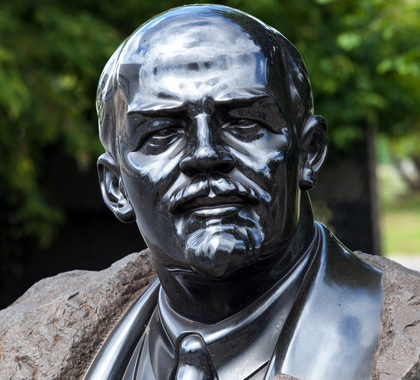November 7 marks a century since the founding of one of the most murderous tyrannies in human history. Russia’s communist empire was an appalling failure in every way, yet we often see the hammer and sickle, the symbol of the Soviet Union, carried on college campuses and at protests around the country. Communism still holds sway among a significant part of the U.S. population.
In 1917, Russia was ruled by a powerful tsar. But in the preceding decades, reformers had been chipping away at the feudal system, which was all Russia had ever known. More democratic and free-market ideas were taking hold. Most of the peasant masses, however, were still impoverished, and millions of Russian men were being used as cannon fodder in World War I. The process of change accelerated in March 1917, when reformers forced the tsar to cede power.
Elections were planned for a democratic assembly, the Duma.
The Bolsheviks, however, had been agitating and organizing an alternative to the democratic reformers. Led by Vladimir Lenin, this group of communists staged a coup on Nov. 7, 1917.
What followed was not an open society with economic opportunity and democratic institutions, much less a workers’ paradise. Far from it. The communists could not sustain an economy. The regime engineered a catastrophic famine deliberately to starve to death millions of small farmers, who, the communists feared, could resist the regime’s confiscation of their land. Millions more innocent people were murdered by firing squads or worked to death in the Gulag slave labor camps.
The Soviet Union was the first modern totalitarian regime. Private life and private enterprise were forbidden. Everything was political. Spies were everywhere, watching for any deviation from dogma in thought or deed. From its inception to its 1991 demise, the Soviet regime murdered 50 million individuals, according to the best estimates. Other communist regimes established, abetted, or inspired by the Soviet Union – in China, Cambodia, North Korea – brought the body count as high as 150 million.
In the United States today, the media rightly deplore and ostracize bigoted brutes who march under the swastika. When Antifa thugs parade under the hammer and sickle and do violence to peaceful demonstrators, however, they are commonly given a chorus of approval or at least tolerance among the nation’s elites, who profess to disagree with their tactics while honoring their intentions: achievement of “social justice,” which translates to socialism under ironhanded rule by elites.
Three insights help explain this morally sick phenomenon.
First, communism is a collectivist ideology. It puts the group – in this case, the so-called proletariat of downtrodden workers – ahead of the individual, and it characterizes all social life as a war between rich and poor. The individual is routinely sacrificed for the good of society, often fatally. Whereas, historically, Americans defended free association among individuals – family, friends, social organizations, and other components of civil society – today, many reject the nation’s founding principle of free association and individual liberty and actively work to undermine all groups not created by the state.
Second, communism contains a strong element of envy. Instead of wanting to allow everyone to proper, communism and its little brother, socialism, works to pull down those who already prosper. “Take from the one percent!” they shout. Or the 10 percent. Or the 20 percent. Never mind that allowing people to retain their wealth creates greater wealth that benefits everybody, resulting in the most prosperous society the world has ever known. Instead, a large class of privileged ingrates enjoys the riches created by others even as their ugly, angry, tear-it-down envy, combined with collectivist dogma, drives their denunciations of the creators of the system, their guilt-tripping against productive individuals, and their condemnation of entire ethnic groups for their “shameful” history of productive virtues. These malcontents share the motives of the Marxists, who, a century ago, sought to destroy not only feudal oligarchs, but also entrepreneurial wealth-creators.
A third insight is that a long-term communist strategy is in full operation in this country. Italian communist Antonio Gramsci in the early twentieth century explained the importance of taking over a nation’s culture to prepare the ground for political revolution. In the 1960s, the German red Rudi Dutschke called this the “long march through the institutions.” Individuals who accept collectivist principles gradually become the politicians, entertainers, teachers, educators, lawyers, media moguls, and journalists who mold the culture and spread their values throughout society, strengthening their efforts by suppressing freedom of speech whenever they have the power to do so. Within a few generations, a country is ripe for a collectivist revolution.
Today, the United States is not in danger of becoming another Soviet Union. Yet cultural elites are steadily spreading the premise that we all owe allegiance first and foremost to one another, not to those whom we value and who enhance our flourishing, such as family and friends. This ultimately puts government at the head of everything, with claims that its activities represent some “general will” about the good of society. There is no private life. Everything is political.
On the one hundredth anniversary of the establishment of the Soviet tyranny, it is crucial that those of us who still live by American values – individual liberty, self-reliance, voluntary assistance to others, and limited government – understand the significance of some of our countrymen not abhorring the hammer and sickle as they do the swastika. We must devise our own “long march through the institutions” to preserve the values that make America great by allowing each individual to achieve his own greatness.
[Originally Published at American Thinker]
For further reading:
Edward Hudgins, “Eastern Europe 20 Years Later,” December 24, 2009.
Edward Hudgins, “The Berlin Wall Then and Now,” November 5, 2009.





